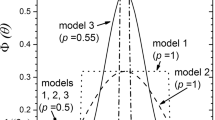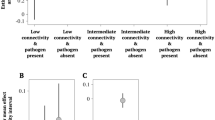Abstract
It is an accepted principle in biogeography that the distributions of organisms are primarily controlled by the climate1–3; thus it is widely supposed that the geographical distribution limits of plants can be explained in terms of their physiological responses to particular climatic factors. However, such responses have rarely been demonstrated at natural distribution limits3; those responses that are reported generally have such small effects on survival that it is hard to explain how control could really be exercised by them. Those seeking explanations of distribution limits have, however, largely neglected the impermanence of the colonies constituting them. We suggest here that it is necessary to consider not only the effects of the climate on the performance of plants within existing sites but also the impact that these primary effects may have on the invasion of new sites. Epidemic models of the invasion process result in threshold theorems which explain how small changes in plant performance could result in large changes in the probability of new colonies appearing.
This is a preview of subscription content, access via your institution
Access options
Subscribe to this journal
Receive 51 print issues and online access
$199.00 per year
only $3.90 per issue
Buy this article
- Purchase on Springer Link
- Instant access to full article PDF
Prices may be subject to local taxes which are calculated during checkout
Similar content being viewed by others
References
Good, R. New Phytol. 30, 149–171 (1931).
Cain, S. A. Foundation of Plant Geography (Harper, New York, 1944).
Pigott, C. D. in The Flora of a Changing Britain (ed. Perring, F. H.) 32–44 (Botanical Society of the British Isles & Classey, Hampton, 1970).
Salisbury, E. J. Geogrl J. 57, 312–335 (1926).
Iversen, J. Geol För. Stockh. Förh. 66, 463–483 (1944).
Dahl, E. Oikos 3, 22–52 (1951).
Perring, F. H. & Walters, S. M. (eds) Atlas of the British Flora (Botanical Society of the British Isles & Nelson, Cambridge, 1962).
Conolly, A. P. & Dahl, E. in Studies in the Vegetational History of the British Isles (eds Walker, D. & West, R. G.) 159–223 (Cambridge University Press, London, 1970).
Ratcliffe, D. N. New Phytol. 67, 365–439 (1968).
Davison, A. W. J. Ecol. 58, 453–466 (1970).
Climatological Atlas of the British Isles (Meteorological Office, London, 1952).
Pigott, C. D. Weather, Lond. 30, 82–90 (1975).
Salisbury, E. J. Trans. Norfolk Norwich Nat. Soc. 13, 191–263 (1932).
Southward, A. J. & Crisp, D. J. J. Anim. Ecol. 23, 163–177 (1954).
Salisbury, E. J. in The Changing Flora of Britain (ed. Lousley, J. E.) 130–139 (Botanical Society of the British Isles, London, 1953).
Harper, J. L. Population Biology of Plants (Academic, London, 1977).
Bailey, N. T. J. The Mathematical Theory of Infectious Diseases (Griffin, London,1975).
Becker, N. Biometrics 35, 295–305 (1979).
Levins, R. Lect. Math. Life Sci. 2, 77–107 (1970).
Kermack, W. O. & McKendrick, A. G. Proc. R. Soc. A115, 700–721 (1927).
Whittle, P. Biometrika 42, 154–162 (1955).
Becker, N. Theor. Populat. Biol. 11, 23–36 (1977).
May, R. Stability and Complexity in Model Ecosystems, 2nd edn (Princeton University Press, 1974).
Salisbury, E. J. Weeds and Aliens (Collins, London, 1961).
Author information
Authors and Affiliations
Rights and permissions
About this article
Cite this article
Carter, R., Prince, S. Epidemic models used to explain biogeographical distribution limits. Nature 293, 644–645 (1981). https://doi.org/10.1038/293644a0
Received:
Accepted:
Issue Date:
DOI: https://doi.org/10.1038/293644a0
This article is cited by
-
Improving climate suitability for Bemisia tabaci in East Africa is correlated with increased prevalence of whiteflies and cassava diseases
Scientific Reports (2020)
-
Intraspecific lineages as focal points in the extinction and persistence of species
Plant Systematics and Evolution (2019)
-
Success, failure, and spreading speeds for invasions on spatial gradients
Journal of Mathematical Biology (2015)
-
Pest species distribution modelling: origins and lessons from history
Biological Invasions (2014)
-
Range structure analysis: unveiling the internal structure of species’ ranges
Theoretical Ecology (2013)
Comments
By submitting a comment you agree to abide by our Terms and Community Guidelines. If you find something abusive or that does not comply with our terms or guidelines please flag it as inappropriate.



